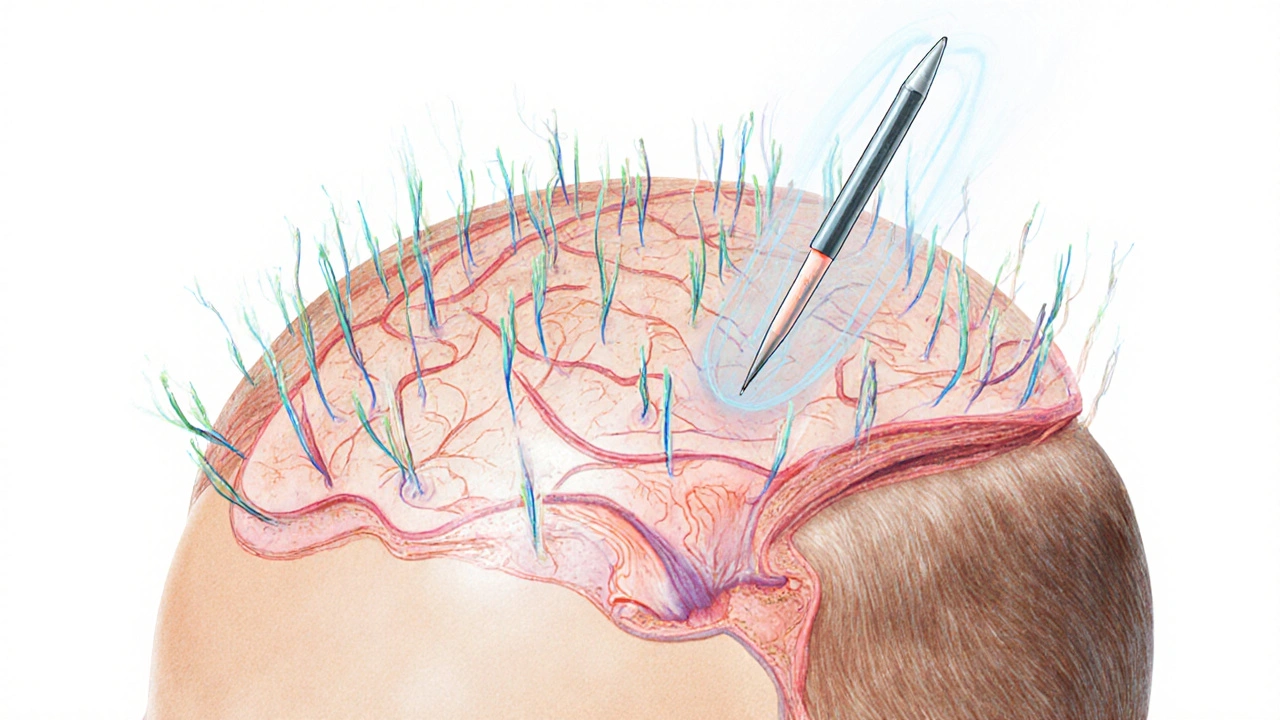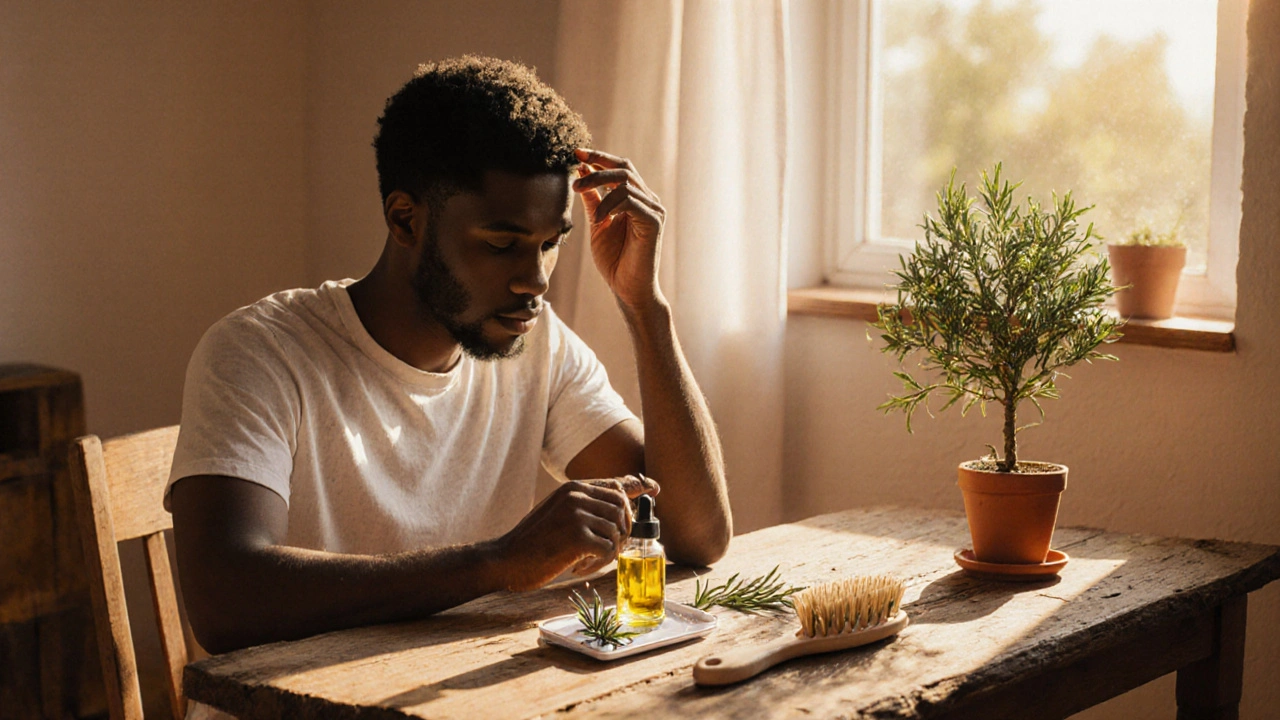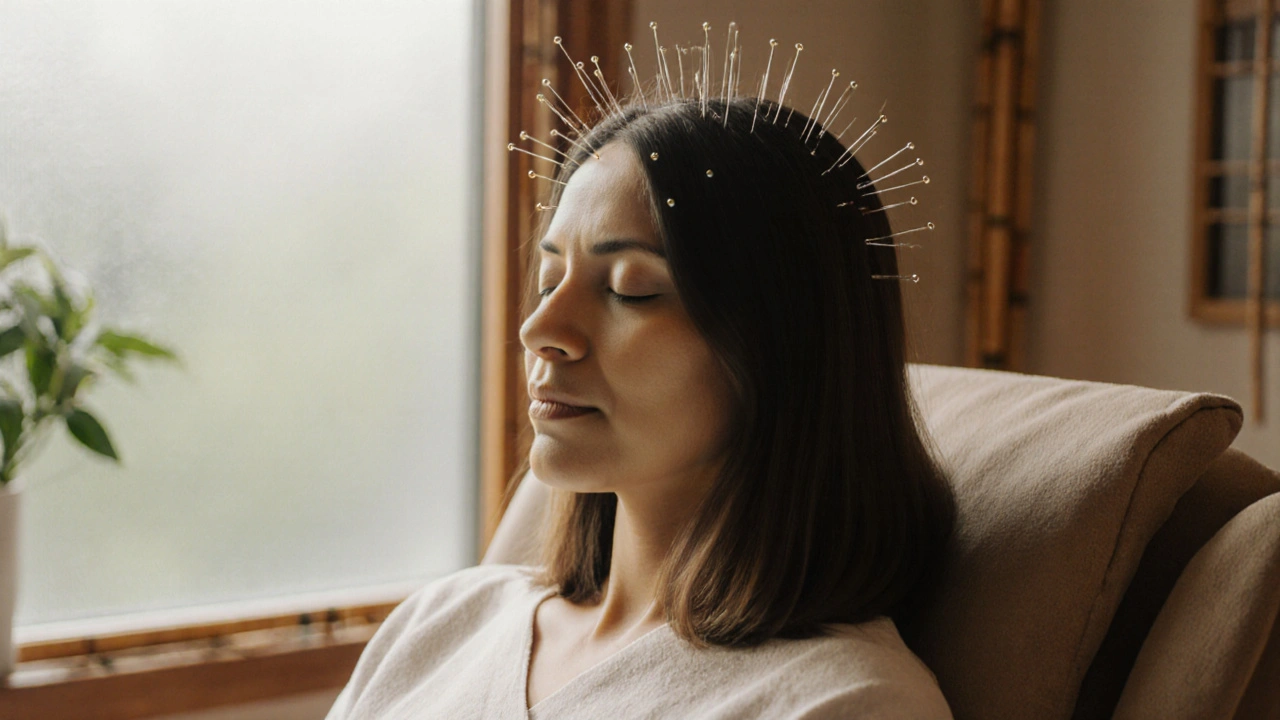Acupuncture is a Traditional Chinese Medicine (TCM) technique that uses ultra‑thin needles inserted at specific points to balance the body’s energy flow, known as . Practitioners believe that correcting disruptions in this flow can improve organ function, blood circulation, and even hair growth.
Alopecia refers to a group of conditions characterized by hair loss, ranging from to . Over 80 million adults in the United States experience some form of alopecia, and the psychological impact can be significant.
Why acupuncture for alopecia is gaining attention
People are turning to holistic options when conventional drugs like minoxidil or steroids either don’t work or cause side effects. Acupuncture offers a low‑risk, non‑pharmaceutical route that targets the root causes many clinicians identify: poor scalp circulation, hormonal imbalance, and chronic inflammation. By stimulating specific Meridians, the needle points can modulate the nervous system and promote the release of endogenous growth factors essential for hair follicle health.
How acupuncture interacts with the hair growth cycle
Hair follicles go through three phases: anagen (growth), catagen (regression), and telogen (rest). For healthy regrowth, the follicle must spend ample time in anagen. Research suggests that acupuncture can:
- Increase local Blood circulation, delivering oxygen and nutrients needed for follicle activity.
- Reduce scalp inflammation by lowering pro‑inflammatory cytokines, which often trigger premature entry into telogen.
- Balance hormones such as dihydrotestosterone (DHT) that contribute to androgenetic alopecia.
- Stimulate Immune modulation, especially helpful for autoimmune‑driven alopecia areata.
In practical terms, a typical treatment plan includes 8‑12 weekly sessions, each lasting 30‑45 minutes. Needles are placed on points like Zu San Li (ST36), Du 20 (GV20), and scalp-specific locations aligned with the hair‑growing meridians.
What the science says
While large‑scale randomized trials are still scarce, several studies provide promising data:
- In a 2022 Chinese clinical trial involving 94 participants with alopecia areata, 68% experienced ≥30% hair regrowth after 12 weeks of acupuncture combined with a low‑dose herbal formula.
- A 2020 meta‑analysis of six small trials (total N=312) reported a statistically significant improvement in hair density for patients receiving acupuncture versus placebo or no treatment.
- Animal studies have shown that needling at scalp points upregulates vascular endothelial growth factor (VEGF), a protein crucial for hair follicle angiogenesis.
Authoritative bodies such as the National Center for Complementary and Integrative Health (NCCIH) acknowledge acupuncture’s role in modulating stress hormones-an indirect but relevant benefit for stress‑related hair loss.
What to expect during a session
During your first visit, the practitioner will conduct a thorough intake, reviewing medical history, hair‑loss pattern, and lifestyle factors. This is where Traditional Chinese Medicine diagnosis-often expressed as a pattern of “Qi deficiency” or “Blood stagnation”-guides point selection.
- Preparation: No need to shave the scalp; a clean, comfortable environment is enough.
- Needling: Stainless‑steel needles (0.25mm diameter) are inserted at shallow depths (5‑15mm) and may be gently twisted or stimulated electrically for an additional effect.
- Duration: Needles stay in place for 20‑30minutes while you relax or listen to soft music.
- Aftercare: Light massage, warm compress, and a recommendation to avoid hot showers or strenuous exercise for 1‑2hours.
Most people report a subtle warmth or tingling sensation at the point sites-signs that the nervous system is responding.

Combining acupuncture with other hair‑loss strategies
Acupuncture works best as part of a holistic plan. Consider pairing it with:
| Treatment | Mechanism | Typical Success Rate | Side Effects |
|---|---|---|---|
| Acupuncture | Energy balancing, blood flow, immune modulation | 30‑70% (varies by type) | Minor bruising, temporary soreness |
| Minoxidil (topical) | Vasodilation, follicle stimulation | 40‑60% | Scalp irritation, unwanted hair growth |
| Corticosteroid injections | Anti‑inflammatory, immune suppression | 45‑55% (alopecia areata) | Skin atrophy, pain |
| Platelet‑Rich Plasma (PRP) | Growth factor delivery | 35‑50% | Temporary swelling, bruising |
For example, a patient with androgenetic alopecia might use minoxidil nightly while receiving weekly acupuncture to improve scalp microcirculation. The synergistic effect often leads to better outcomes than either approach alone.
Safety, contraindications, and common myths
Acupuncture is generally safe when performed by a licensed practitioner. However, keep these points in mind:
- Pregnancy: Certain points (e.g., LI4) are avoided because they may induce uterine contractions.
- Bleeding disorders: Patients on anticoagulants should discuss needle depth and location.
- Skin infections: Active scalp infections must be treated before needling.
Myth‑busting:
- ‘Acupuncture is painful.’ - Most people feel only a mild pressure.
- ‘It can’t work for severe baldness.’ - While it may not regrow long strands in extensive bald areas, it can stabilize loss and thicken existing hair.
- ‘Only Asian patients benefit.’ - Studies across diverse ethnic groups show similar physiological responses.
Choosing the right practitioner
Not all needle‑wielders are created equal. Look for:
- Licensure from a recognized acupuncture board (e.g., NCCAOM in the U.S.).
- Specialization or experience in dermatological or hair‑loss cases.
- Willingness to collaborate with your dermatologist or primary care physician.
During the initial consult, ask about their diagnostic framework, typical session frequency, and any recommended lifestyle changes (diet, stress management, sleep hygiene) that support hair health.
Bottom line: is acupuncture worth trying?
If you’ve exhausted-or are hesitant about-pharmaceutical routes, acupuncture offers a low‑risk, evidence‑backed alternative that targets the body’s internal balance rather than just the scalp. Results vary, but many patients report slower shedding, thicker strands, and a psychological boost from taking an active role in their healing.

Frequently Asked Questions
How many acupuncture sessions are needed to see hair growth?
Most clinicians recommend 8‑12 weekly sessions before evaluating visible changes. Some patients notice a reduction in shedding within 3‑4 weeks, while noticeable regrowth can take 3‑6 months.
Can acupuncture be combined with minoxidil or finasteride?
Yes. In fact, many dermatologists recommend a combined approach. Acupuncture improves scalp circulation, which can enhance the delivery of topical agents like minoxidil. Just keep your physician in the loop.
Is acupuncture safe for children with alopecia areata?
Pediatric acupuncture is practiced in many clinics, using finer needles and gentler stimulation. Studies on children with alopecia areata show comparable safety profiles to adults, but always choose a practitioner experienced with pediatric cases.
What lifestyle changes boost acupuncture results?
Stress reduction (meditation, yoga), a diet rich in omega‑3 fatty acids, adequate sleep (7‑8hours), and avoiding harsh hair chemicals all complement the physiological effects of acupuncture.
Are there any side effects I should watch for?
Most side effects are mild: temporary bruising, slight soreness, or faintness. Rarely, infection can occur if sterile technique isn’t followed. Report any prolonged redness or swelling to your practitioner promptly.


Dawn Midnight
I've noticed a minor typographical inconsistency in the section discussing "blood circulation". The phrase "Blood circulation" should be capitalised consistently throughout the article. Additionally, the abbreviation for "Traditional Chinese Medicine" could be introduced earlier to aid readability. Overall the content is informative, though a few copy‑editing tweaks would improve professionalism.
frank hofman
Yo, I get what you're saying but honestly the whole "capitalisation" fuss seems kinda overblown 😂. I mean, who even reads that stuff anyway? The vibe of the article is chill and the facts still hold, typo or not. Plus, a little chaos keeps things interesting, right?
Dannii Willis
Thanks for sharing this comprehensive overview! The way you broke down the hair growth cycle alongside the acupuncture points really helps bridge the gap between TCM theory and modern dermatology. I appreciate the inclusion of both quantitative study results and practical session expectations. It makes it easier for readers to decide if they want to explore this modality.
Robyn Du Plooy
Building on that, the modulation of the neurovascular axis via ST36 and GV20 can be conceptualized as a physiologic upregulation of angiogenic pathways, specifically through VEGF and nitric oxide synthase activation. From a bio‑psycho‑social perspective, integrating meridian‑based interventions with standard pharmacotherapy may attenuate the hypothalamic‑pituitary‑adrenal (HPA) axis hyperactivity often implicated in stress‑induced telogen effluvium. Hence, the synergistic framework you outlined aligns with emerging integrative models of hair‑follicle homeostasis.
Boyd Mardis
Acupuncture could be the plot twist your hair story needed!
ayan majumdar
yeah its true many people miss that the needles actually stimulate micro‑circulation which can help hair grow faster but you should still see a doctor just in case
Johnpaul Chukwuebuka
Exactly! Trust the process, stay consistent with weekly visits, and combine it with a balanced diet rich in omega‑3s. You’ll likely notice less shedding within a month and gradual regrowth after a few more sessions. Keep the momentum and don’t forget to relax between appointments – stress management is key!
Xavier Hernandez
Let’s paint a vivid picture: imagine each tiny needle as a brushstroke on the canvas of your scalp, coaxing dormant follicles to awaken like sunrise over a misty valley. The kaleidoscopic dance of qi, blood, and hormones creates a symphony of growth that’s as poetic as it is physiological. If you’re craving a holistic brush‑with destiny, acupuncture might just be the masterpiece your mane deserves.
Zach Yeager
While all that poetic fluff sounds nice, let’s be real – American healthcare should focus on proven FDA‑approved treatments, not imported mysticism. We’ve got enough home‑grown research; leaning on foreign practices only dilutes our standards. Stick with what’s been vetted right here, folks.
Angel Gallegos
One must commend the author for assembling a rather exhaustive compendium; nevertheless, the prose occasionally lapses into pedestrian exposition, diluting its scholarly gravitas. A more rigorous lexicon, coupled with stringent adherence to the Chicago Manual, would elevate this treatise from merely informative to truly erudite. Moreover, the reliance on anecdotal evidence betrays an implicit bias that undermines the article’s purported objectivity.
ANTHONY COOK
Look, I get the elitist vibes, but the real world’s messy and people need options 😒. Cutting‑edge science is great, yet dismissing centuries‑old modalities because they’re “foreign” feels narrow‑minded. If someone finds relief, who are we to police their choices? 🤷♂️
Sarah Aderholdt
Healing, whether through needles or molecules, fundamentally reflects the body's pursuit of equilibrium. Embracing multiple pathways acknowledges both the scientific and the experiential dimensions of wellness.
Phoebe Chico
Indeed, one could argue that the scalp is a micro‑cosmos where entropy and order constantly vie for dominance, and acupuncture serves as a catalyst for re‑establishing harmony. In the grand tapestry of self‑care, each thread-be it herbal, hormonal, or needle‑based-contributes to the vibrant mosaic of personal resilience.
Larry Douglas
While the integration of acupuncture into hair‑loss treatment regimens has garnered increasing attention, a rigorous appraisal of the existing literature is warranted. The methodological heterogeneity observed across the cited studies-including variations in needle placement, session frequency, and adjunctive herbal formulations-complicates direct comparison of outcomes. Moreover, many trials suffer from limited sample sizes, thereby reducing statistical power and increasing susceptibility to type II errors. Nonetheless, the reported effect sizes in the 2022 Chinese clinical trial suggest a clinically meaningful response in a substantial proportion of participants. A meta‑analysis encompassing six smaller investigations further substantiates a modest yet statistically significant improvement in hair density relative to control conditions. It is imperative to recognize that the physiological mechanisms posited-enhanced microvascular perfusion, modulation of inflammatory cytokines, and regulation of androgenic pathways-are biologically plausible and align with contemporary understandings of follicular biology. Future research should prioritize double‑blind designs, standardized acupuncture protocols, and long‑term follow‑up to ascertain durability of therapeutic benefit. Additionally, stratification of participants by alopecia etiology would elucidate differential responsiveness among androgenetic, alopecia areata, and telogen effluvium cohorts. Cost‑effectiveness analyses are also necessary to determine the economic viability of routine acupuncture within mainstream dermatologic practice. From a safety perspective, the incidence of adverse events remains low, with minor bruising and transient soreness constituting the most common reports. However, clinicians must remain vigilant regarding contraindications such as coagulopathies and active infections. Patient-reported outcomes, such as quality‑of‑life measures, should also be incorporated to capture the psychosocial impact of hair regrowth. Furthermore, interdisciplinary collaboration between licensed acupuncturists and board‑certified dermatologists can facilitate comprehensive care plans. Regulatory bodies may consider establishing certification pathways specific to dermatologic acupuncture to ensure practitioner competency. Ultimately, the convergence of traditional wisdom and modern evidence may broaden the therapeutic armamentarium available to individuals grappling with alopecia.
Michael Stevens
Great synthesis, Larry. For anyone thinking about trying acupuncture, I’d recommend finding a practitioner who collaborates with your dermatologist, setting realistic expectations, and tracking progress with photos. Consistency and patience are key-most people see subtle improvements after a few months rather than overnight miracles. You’ve got this!